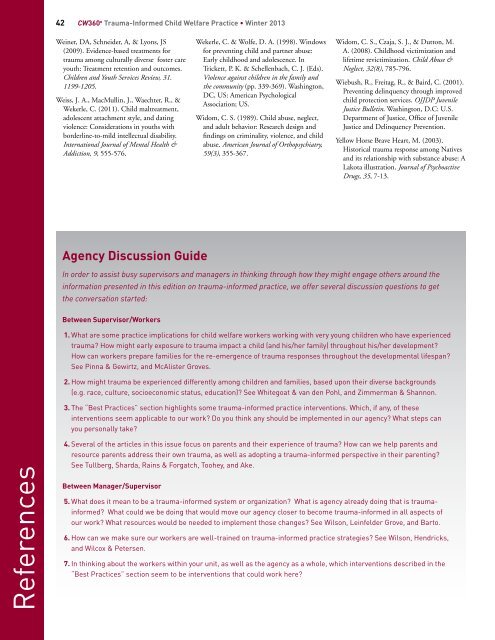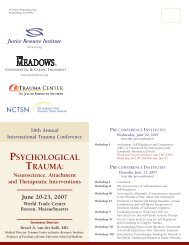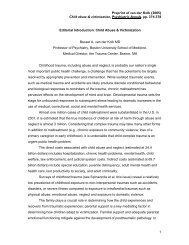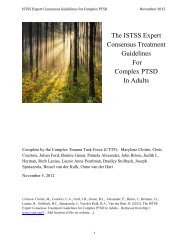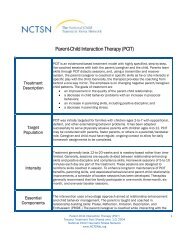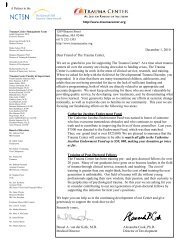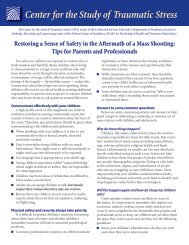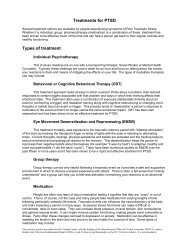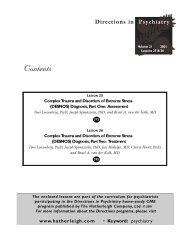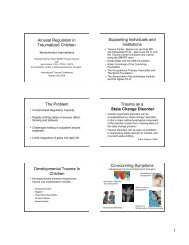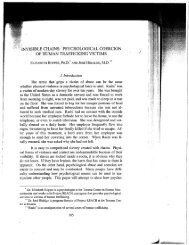in Child Welfare - The Trauma Center
in Child Welfare - The Trauma Center
in Child Welfare - The Trauma Center
Create successful ePaper yourself
Turn your PDF publications into a flip-book with our unique Google optimized e-Paper software.
42 CW360 o <strong>Trauma</strong>-Informed <strong>Child</strong> <strong>Welfare</strong> Practice • W<strong>in</strong>ter 2013We<strong>in</strong>er, DA, Schneider, A, & Lyons, JS(2009). Evidence-based treatments fortrauma among culturally diverse foster careyouth: Treatment retention and outcomes.<strong>Child</strong>ren and Youth Services Review, 31.1199-1205.Weiss, J. A., MacMull<strong>in</strong>, J., Waechter, R., &Wekerle, C. (2011). <strong>Child</strong> maltreatment,adolescent attachment style, and dat<strong>in</strong>gviolence: Considerations <strong>in</strong> youths withborderl<strong>in</strong>e-to-mild <strong>in</strong>tellectual disability.International Journal of Mental Health &Addiction, 9, 555-576.Wekerle, C. & Wolfe, D. A. (1998). W<strong>in</strong>dowsfor prevent<strong>in</strong>g child and partner abuse:Early childhood and adolescence. InTrickett, P. K. & Schellenbach, C. J. (Eds).Violence aga<strong>in</strong>st children <strong>in</strong> the family andthe community (pp. 339-369). Wash<strong>in</strong>gton,DC, US: American PsychologicalAssociation; US.Widom, C. S. (1989). <strong>Child</strong> abuse, neglect,and adult behavior: Research design andf<strong>in</strong>d<strong>in</strong>gs on crim<strong>in</strong>ality, violence, and childabuse. American Journal of Orthopsychiatry,59(3), 355-367.Widom, C. S., Czaja, S. J., & Dutton, M.A. (2008). <strong>Child</strong>hood victimization andlifetime revictimization. <strong>Child</strong> Abuse &Neglect, 32(8), 785-796.Wiebush, R., Freitag, R., & Baird, C. (2001).Prevent<strong>in</strong>g del<strong>in</strong>quency through improvedchild protection services. OJJDP JuvenileJustice Bullet<strong>in</strong>. Wash<strong>in</strong>gton, D.C: U.S.Department of Justice, Office of JuvenileJustice and Del<strong>in</strong>quency Prevention.Yellow Horse Brave Heart, M. (2003).Historical trauma response among Nativesand its relationship with substance abuse: ALakota illustration. Journal of PsychoactiveDrugs, 35, 7-13.Agency Discussion GuideIn order to assist busy supervisors and managers <strong>in</strong> th<strong>in</strong>k<strong>in</strong>g through how they might engage others around the<strong>in</strong>formation presented <strong>in</strong> this edition on trauma-<strong>in</strong>formed practice, we offer several discussion questions to getthe conversation started:Between Supervisor/Workers1. What are some practice implications for child welfare workers work<strong>in</strong>g with very young children who have experiencedtrauma? How might early exposure to trauma impact a child (and his/her family) throughout his/her development?How can workers prepare families for the re-emergence of trauma responses throughout the developmental lifespan?See P<strong>in</strong>na & Gewirtz, and McAlister Groves.2. How might trauma be experienced differently among children and families, based upon their diverse backgrounds(e.g. race, culture, socioeconomic status, education)? See Whitegoat & van den Pohl, and Zimmerman & Shannon.3. <strong>The</strong> “Best Practices” section highlights some trauma-<strong>in</strong>formed practice <strong>in</strong>terventions. Which, if any, of these<strong>in</strong>terventions seem applicable to our work? Do you th<strong>in</strong>k any should be implemented <strong>in</strong> our agency? What steps canyou personally take?References4. Several of the articles <strong>in</strong> this issue focus on parents and their experience of trauma? How can we help parents andresource parents address their own trauma, as well as adopt<strong>in</strong>g a trauma-<strong>in</strong>formed perspective <strong>in</strong> their parent<strong>in</strong>g?See Tullberg, Sharda, Ra<strong>in</strong>s & Forgatch, Toohey, and Ake.Between Manager/Supervisor5. What does it mean to be a trauma-<strong>in</strong>formed system or organization? What is agency already do<strong>in</strong>g that is trauma<strong>in</strong>formed?What could we be do<strong>in</strong>g that would move our agency closer to become trauma-<strong>in</strong>formed <strong>in</strong> all aspects ofour work? What resources would be needed to implement those changes? See Wilson, Le<strong>in</strong>felder Grove, and Barto.6. How can we make sure our workers are well-tra<strong>in</strong>ed on trauma-<strong>in</strong>formed practice strategies? See Wilson, Hendricks,and Wilcox & Petersen.7. In th<strong>in</strong>k<strong>in</strong>g about the workers with<strong>in</strong> your unit, as well as the agency as a whole, which <strong>in</strong>terventions described <strong>in</strong> the“Best Practices” section seem to be <strong>in</strong>terventions that could work here?


